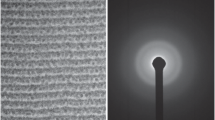Abstract
Solid-state amorphization was achieved in the Ni48Nb52 multilayers upon thermal annealing by gradually raising the temperature from 250 to 400 °C and staying at 400 °C for 2 h. More interestingly, before complete amorphization, a sequential disordering of first Ni and then Nb crystalline lattices was observed for the first time, and it was essentially the physical origin of an asymmetric growth of the amorphous interlayer during solid-state reaction reported previously in some binary metal systems. In another two multilayered samples with overall compositions of Ni64Nb36 and Ni70Nb30, thermal annealing under similar conditions resulted in the formation of two metastable crystalline phases with face-centered-cubic and hexagonal-close-packed structures, respectively, although an amorphous phase also appeared and coexisted with one of the metastable crystalline phases in the intermediate states. In the ion mixing experiment, such sequential disordering, as well as formation of metastable phases, was also observed in the respective Ni–Nb multilayers upon room-temperature 200-keV xenon ion irradiation. Comparatively, however, ion irradiation eventually induced complete amorphization in all the multilayers at the respective doses, indicating that ion-induced disordering frequently predominated in the competition between amorphization and the growth of a metastable crystalline phase. A Gibbs free energy diagram, including the free energy curves of the newly formed metastable crystalline phases, of the Ni–Nb system was calculated based on Miedema’s model. The constructed free energy diagram can give reasonable explanations of the sequential disordering and the thermodynamic possibility of the formation of either an amorphous or a metastable crystalline phase, of which the free energy difference was quite small. It follows naturally that the phase selection, namely, which phase was more favored to be formed eventually than its competitors, was influenced or even determined by the kinetics involved in the respective processes.
Similar content being viewed by others
References
W.L. Johnson, Prog. Mater. Sci. 30, 81 (1986).
A. Blatter and M. Von Allmen, Phys. Rev. Lett. 54, 2103 (1985).
H.U. Krebs, D.J. Webb, and A.F. Marshall, Phys. Rev. B 35, 5393 (1987).
R.B. Schwarz and W.L. Johnson, Phys. Rev. Lett. 51, 415 (1985).
K. Samwer, H.J. Fecht, and W.L. Johnson, in Topics in Applied Physics: Amorphization in Metallic Systems, edited by B. Guntherodt (Springer-Verlag Berlin Heidelberg, 1994), Vol. 72, p. 26.
E. Ma, C.W. Niel, M.A. Nicolet, and W.L. Johnson, J. Mater. Res. 4, 1299 (1989).
J.R. Ding, D.Z. Che, H.B. Zhang, K. Tao, and B.X. Liu, Appl. Phys. Lett. 60, 944 (1992).
Z.J. Zhang and B.X. Liu, J. Appl. Phys. 76, 3315 (1994).
H. Schroder, K. Samwer, and U. Koster, Phys. Rev. Lett. 54, 197 (1985).
W.J. Meng, C.W. Nieh, and W.L. Johnson, Appl. Phys. Lett. 51, 1693 (1987).
Q. Zhang, W.S. Lai, and B.X. Liu, Phys. Rev. B 58, 14020 (1998).
Z.J. Zhang, H.Y. Bai, Q.L. Qiu, T. Yang, K. Tao, and B.X. Liu, J. Appl. Phys. 73, 1702 (1993).
J.A. Alonso and S. Simozar, Solid State Commun. 46, 765 (1983).
A.R. Miedema, F.R. de Boer, and P.F. de Boer, J. Phys. F3, 1588 (1983).
L.J. Gallego, J.A. Somozar, J.A. Alonso, and J.M. Lopez, Physica B 154, 82 (1988).
A. Blatter, J. Gfeller, and M.V. Allmen, J. Less-Common. Met. 140, 317 (1988).
B.X. Liu and Z.J. Zhang, Phys. Rev. B 49, 12519 (1994).
Z.J. Zhang, O. Jin, and B.X. Liu, Phys. Rev. B 51, 8067 (1995).
Z.J. Zhang and B.X. Liu, Phys. Rev. B 51, 16475 (1995).
Z.J. Zhang and B.X. Liu, J. Appl. Phys. 73, 3315 (1994).
M. Lopez, J.A. Alonso, and L.J. Gallego, Phys. Rev. B 36, 3716 (1987).
A.W. Weeber, J. Phys. E 17, 809 (1987).
A.K. Niessen, A.R. Miedema, F.R. de Boer, and R. Boom, Physica B 151, 401 (1988).
F.R. de Boer, R. Boom, W.C. Matter, A.R. Miedema, and A.K. Niessen, Cohesion in Metals: Transition Metal Alloys (Northland, Amsterdam, 1988).
Q. Zhang, W.S. Lai, and B.X. Liu (unpublished).
C. Kittel, Introduction to Solid State Physics (Wiley, New York, 1966).
Author information
Authors and Affiliations
Corresponding author
Rights and permissions
About this article
Cite this article
Yang, G.W., Lin, C. & Liu, B.X. Phase evolution in Ni–Nb multilayers upon solid-state reaction. Journal of Materials Research 14, 3027–3036 (1999). https://doi.org/10.1557/JMR.1999.0406
Received:
Accepted:
Published:
Issue Date:
DOI: https://doi.org/10.1557/JMR.1999.0406




